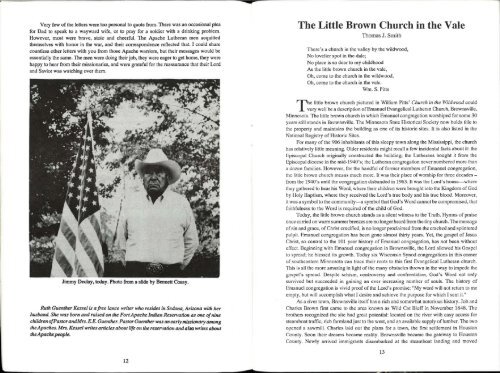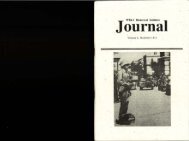journal - WELS Historical Institute
journal - WELS Historical Institute
journal - WELS Historical Institute
You also want an ePaper? Increase the reach of your titles
YUMPU automatically turns print PDFs into web optimized ePapers that Google loves.
Very few of the letters were too personal to quote from. There was an occasional plea<br />
for Dad to speak to a wayward wife, or to pray for a soldier with a drinking problem.<br />
However, most were brave, stoic and cheerful. The Apache Lutheran men acquitted<br />
themselves with honor in the war, and their correspondence reflected that. I could share<br />
countless other letters with you from those Apache warriors, but their messages would be<br />
essentially the same. The men were doing their job, they were eager to get home, they were<br />
happy to hear from their missionaries, and were grateful for the reassurance that their Lord<br />
and Savior was watching over them.<br />
Jimmy DeeJay, today. Photo from a slide by Bennett Cesay.<br />
Ruth Guenther Kessel is a free lance writer who resides in Sedona, Arizona with her<br />
husband. She was born and raised on the Fort Apache Indian Reservation as one a/nine<br />
children a/Pastor andMrs. E.E. Guenther. Pastor Guenther was an early missionary among<br />
the Apaches. Mrs. Kessel-writes articles about life on the reservation and aLm writes about<br />
the-Apache people.<br />
12<br />
The Little Brown Church in the Vale<br />
Thomas J. Smith<br />
There's a church in the valley by the wildwood,<br />
No lovelier spot in the dale;<br />
No place is so dear to my childhood<br />
As the little brown church in the vale,<br />
Oh, come to the church in the wildwood,<br />
Oh, come to the church in the vale.<br />
Wm. S. Pitts<br />
The little brown church pictured in William Pitts' Church ill the Wildwood could<br />
very well be a description of Emanuel Evangelical Lutheran Church, Brownsville,<br />
Minnesota. The little brown church in which Emanuel congregation worshiped for some 30<br />
years still stands in Brownsville. The Minnesota State <strong>Historical</strong> Society now holds title to<br />
the property and maintains the building as one of its historic sites. It is also listed in the<br />
National Registry of Historic Sites.<br />
For many of the 906 inhabitants of this sleepy town along the Mississippi, the church<br />
has relatively little meaning. Older residents might recall a few incidental facts about it: the<br />
Episcopal Church originally constructed the building; the Lutherans bought it from the<br />
Episcopal diocese in the mid-1940's; the Lutheran congregation never numbered more than<br />
a dozen families. However, for the handful of former members of Emanuel congregation,<br />
the little brown church means much more. It was their place of worship for three decadesfrom<br />
the 1940's until the congregation disbanded in 1963. It was the Lord's house-where<br />
they gathered to hear his Word, where their children were brought into the Kingdom of God<br />
by Holy Baptism, where they received the Lord's true body and his true blood. Moreover,<br />
it was a symbol to the community-a symbol that God's Word cannot be compromised, that<br />
failhfulness to the Word is required of the child of God.<br />
Today, the little brown church stands as a silent witness to the Truth. Hymns of praise<br />
once carried on warm summer breezes are no longer heard from the tiny church. The message<br />
of sin and grace, of Christ crucified, is no longer proclaimed from the cracked and splintered<br />
pulpit. Emanuel congregation has been gone almost thirty years. Yet, the gospel of Jesus<br />
Christ, so central to the 101 year history of Emanuel congregation, has not been without<br />
effect. Beginning with Emanuel congregation in Brownsville, the Lord allowed his Gospel<br />
to spread; he blessed its growth. Today six Wisconsin Synod congregations in this corner<br />
of southeastern Minnesota can trace their roots to this first Evangelical Lutheran church.<br />
This is all the more amazing in light of the many obstacles thrown in the way to impede the<br />
gospel's spread. Despite schism, controversy and confrontation, God's Word not only<br />
survived but succeeded in gaining an ever increasing number of souls. The history of<br />
Emanuel congregation is vivid proof of the Lord's promise: "My word will not return to me<br />
empty, but will accomplish what I desire and achieve the purpose for which I sent it."<br />
As a river town, Brownsville itself has a rich and somewhat notorious history. Job and<br />
Charles Brown first came to the area known as Wild Cat Bluff in November 1848. The<br />
brothers recognized the site had great potential: located on the river with easy access for<br />
steamboat traffic, rich farmland just to the west, and an available supply of lumber. The two<br />
opened a sawmill. Charles laid out the plans for a town, the first settlement in Houston<br />
County. Soon their dreams became reality. Brownsville became the gateway to Houston<br />
County. Newly arrived immigrants disembarked at the steamboat landing and moved<br />
13



